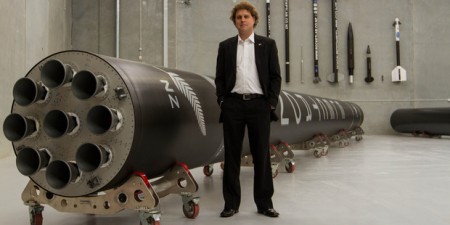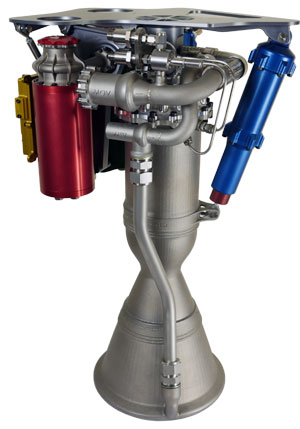April 26, 2015 – A battery-powered rocket? Who would have thunk it?
Well a combined U.S. and New Zealand defense research company, Rocket Lab, partially funded by DARPA and venture capitalists, has developed a rocket called the Electron.
In the picture above, Peter Beck, the company’s CEO, is standing beside an 18-meter (approximately 60 feet) Electron weighing 10.5 tons and capable of launching payloads of 110 kilograms into 500 kilometer orbits above the Earth. First test launch is scheduled for late this year. If successful the company has commitments for has 30 additional launches beginning in 2017 with plans to ramp up to weekly launches by 2018 and up to 100 or more launches a year thereafter.
How does the technology work?
Each Electron features a cluster of Rutherford electric engines. An electric motor turbopump about the size of a beer can is powered by a battery packet generating one megawatt of energy. That amounts to 20,461 newtons (4,600 pounds) of thrust per engine. The picture above shows a cluster of nine engines. Multiply that number by 9 and you get an idea of the thrust capability of each rocket.
Compare that to rockets like the Merlin engine that powers SpaceX’s Falcon 9, each capable of generating 716,000 newtons (161,000 pounds) of thrust, you can immediately see Electron is not competing in the same market as SpaceX. Instead it is hoping to grab the small satellite launch business.
All parts of each Rutherford engine (see picture below) are 3D printed. The rocket frame is constructed from carbon composites providing lightness, strength and capability of withstanding significant heat and pressure.
The engines use liquid oxygen and a specially designed propellant described as a semi-solid to viscous liquid monopropellant (VLM) that is soluble in water and features a high ignition point making it operationally safer than traditional rocket fuels like kerosene and hydrogen. You can watch a demonstration firing of the engine here.
Electron will make New Zealand a space faring nation with launches coming from Down Under. Average cost per launch will be less than $5 million U.S. That may be attractive to small space start ups and academic institutions although payload costs at $49,000 U.S. per kilogram are higher than SpaceX which can launch a kilogram into low-Earth orbit for $4,653. The difference, however, SpaceX launches 6 to 12 times a year whereas Electron is being geared for a much higher frequency schedule.











Looks like it’s just a small thrust 290 pound/second regenerative LOX/RP1 engine with battery powered turbo pumps. That means the turbo pumps (the just about-to-explode pounding hearts of nearly all liquid-propellant rockets) will be extremely reliable and engine start sequence much less critical. The thrust is developed by burning chemical propellants in the thrust chamber and differential gas pressure across the injector face. and nozzle throat area. The electric-motor-driven pumps solve the throttability problem that is so difficult to control with hot gas generator/turbine pump systems. Still, seems like a times-ten cost increase is a high price to pay for very high turbopump reliability and precision thrust throttability. Perhaps there will be rising demand for very high value 250-pound microsatellites in precise low-earth-orbits. But one launch every three days? Seems interesting, but not a game-changer. A real space game-changer must put a pound in orbit for less than $500, maybe even less than $50.
But, it’s hard to put a definite value on utter reliability of short-notice launches. There may be classified military missions where costs don’t matter much, and quick response with total reliability is most important.
Hi Allen, Where I think this technology can play is in the launching of cubesats. A typical launch could carry a number of these micro-satellites into orbit defraying the high cost per pound to some extent. And if it can equal the ambitious launch schedule, would to some degree democratize access to outer space.